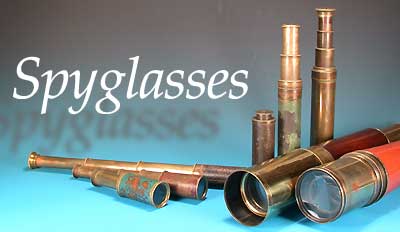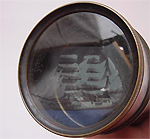
 here were hundreds of makers of spyglasses over the last three centuries, and without an engraved name, there is little
or no hope of identifying the maker of a telescope. Many forgeries are to be found in auctions since it is easy to engrave
a well-known name onto the brass tube of a scope. The best place to get a feel for the value of a spyglass is to watch the
sales on internet auctions, since this will tell you what people are willing to pay for a certain size telescope in a given
condition. Many of the scopes were produced for the use of the navy in different countries. Although England, France, and
Germany led the world in the production of spyglasses, there are some excellent examples from 18th and 19th century Japan
and China. These are more rare than the European scopes.
here were hundreds of makers of spyglasses over the last three centuries, and without an engraved name, there is little
or no hope of identifying the maker of a telescope. Many forgeries are to be found in auctions since it is easy to engrave
a well-known name onto the brass tube of a scope. The best place to get a feel for the value of a spyglass is to watch the
sales on internet auctions, since this will tell you what people are willing to pay for a certain size telescope in a given
condition. Many of the scopes were produced for the use of the navy in different countries. Although England, France, and
Germany led the world in the production of spyglasses, there are some excellent examples from 18th and 19th century Japan
and China. These are more rare than the European scopes.
 The only way to judge the quality of a telescope is to use it. Careful examination
of its condition, how easily it draws, the sharpness and quality of the image
and the mechanical integrity of the scope all figure into its value. The condition
of the tubing (dents, polish, etc) and the leather wrapping or wooden tube (if
present) all need to be considered. Does it have a sharp field stop around the
edges of the image or does the image simply blur into darkness around the edges?
In the end, a thing is only worth what someone is willing to pay for it, so
watch the auctions! Following is a guide to some of the most well-known makers
of spyglasses.
The only way to judge the quality of a telescope is to use it. Careful examination
of its condition, how easily it draws, the sharpness and quality of the image
and the mechanical integrity of the scope all figure into its value. The condition
of the tubing (dents, polish, etc) and the leather wrapping or wooden tube (if
present) all need to be considered. Does it have a sharp field stop around the
edges of the image or does the image simply blur into darkness around the edges?
In the end, a thing is only worth what someone is willing to pay for it, so
watch the auctions! Following is a guide to some of the most well-known makers
of spyglasses.
Broadhurst, Clarkson & Co. Benjamin Martin established an instrument business in 1750. His son Joshua joined him in 1778 and in 1782 he patented a method for producing brass tubing. The same year Charles Tulley bought the firm. His family owned the business until 1844, when it was bought and developed by Robert Mills who ran it until 1873 when he, in turn, sold it to Alexander Clarkson.
 Mr. Broadhurst joined the firm as a partner in 1892, but Clarkson and he fell
out in 1908 and Broadhurst moved to 63 Farringdon Road, EC1, naming the building
Telescope House but trading as "Broadhurst Clarkson & Co. Clarkson
had a top reputation and Broadhurst wished to trade on it, as well as wishing
to annoy Clarkson.
Mr. Broadhurst joined the firm as a partner in 1892, but Clarkson and he fell
out in 1908 and Broadhurst moved to 63 Farringdon Road, EC1, naming the building
Telescope House but trading as "Broadhurst Clarkson & Co. Clarkson
had a top reputation and Broadhurst wished to trade on it, as well as wishing
to annoy Clarkson.
Telescope House produced very high quality astronomical telescopes from 2-inch to 6-inch in diameter. The building housed lens-making facilities a light machine shop and a thriving brass tube-making plant, using a brass drawing machine patented by Joshua Martin in 1782. The premises also had a showroom and shop, which is still in use today.
Between 1914 and 1918, as part of the war effort, the company set up further telescope factories in Watford, and a lens-making facility in central London near Telescope House. During the 1920's and 30's, the business continued to flourish. Around 1950, cheap imports from Japan severely threatened the business. By 1970 all the company's factories had closed except for the manufacturing facilities at Telescope House.
In 1973 Dudley Fuller, a very successful telescope maker with a worldwide reputation, bought the Broadhurst & Clarkson business, renaming it Broadhurst, Clarkson & Fuller. The company distributes Meade Instruments and other astronomical instruments and accessories to a dealership network of nearly 200 retailers throughout the UK.
Dollond Once of the most forged names in antique telescopes. The Dollond family made telescopes for five generations. The family can be traced from the time of the Hugenots in France in the late 17th century down to the great-great grandsons of John Dollond. It was John Dolland who patented the achromatic lens, although the invention was hotly disputed for years. Ten members of the family were telescope makers, including Jesse Ramdsen, who married one of the daughters of John Dolland. Dolland scopes are considered rather more valuable than others, and for this reason the name is often added to a non-Dolland telescope.
 Harris, Thos. & Son This maker
worked between 1800 and 1840. (Battle of Trafalgar/George III/IV / William IV
period). Early scopes were often inscribed with italics on the first draw. Later
(after c. 1880) scopes were inscribed with block printing. This one reads "Thos.
Harris & Son. Opticians to the Royal Family. No.52 Opposite the British Museum.
London". The optics are in very good condition and it has a sliding lens protector
on the eyepiece with a removable brass object lens cover. The object lens cover
does not have to be removed to use as there is a built-in pull-out tab that
acts as a push/pull focusing aid. It measures 8.25 ins closed and 22.5 ins.
extended. Go back to see other pictures
Harris, Thos. & Son This maker
worked between 1800 and 1840. (Battle of Trafalgar/George III/IV / William IV
period). Early scopes were often inscribed with italics on the first draw. Later
(after c. 1880) scopes were inscribed with block printing. This one reads "Thos.
Harris & Son. Opticians to the Royal Family. No.52 Opposite the British Museum.
London". The optics are in very good condition and it has a sliding lens protector
on the eyepiece with a removable brass object lens cover. The object lens cover
does not have to be removed to use as there is a built-in pull-out tab that
acts as a push/pull focusing aid. It measures 8.25 ins closed and 22.5 ins.
extended. Go back to see other pictures
Semitecolo, Leonardo, Venice. Semitecolo spyglasses are seen more often than any other in fleas markets and antique fairs in Europe. Typically signed "Leonardo Semitecolo" or "Leonardo Semitecolo Venezia". These scopes appear to have been manufactured over a long period of time. The earliest date from the third quarter of the 18th century (not from the 17th century, as some authors have claimed). They were produced by many generations, probably by members of the same family, and are still found in very large numbers. Production continued until the middle of the 19th century.